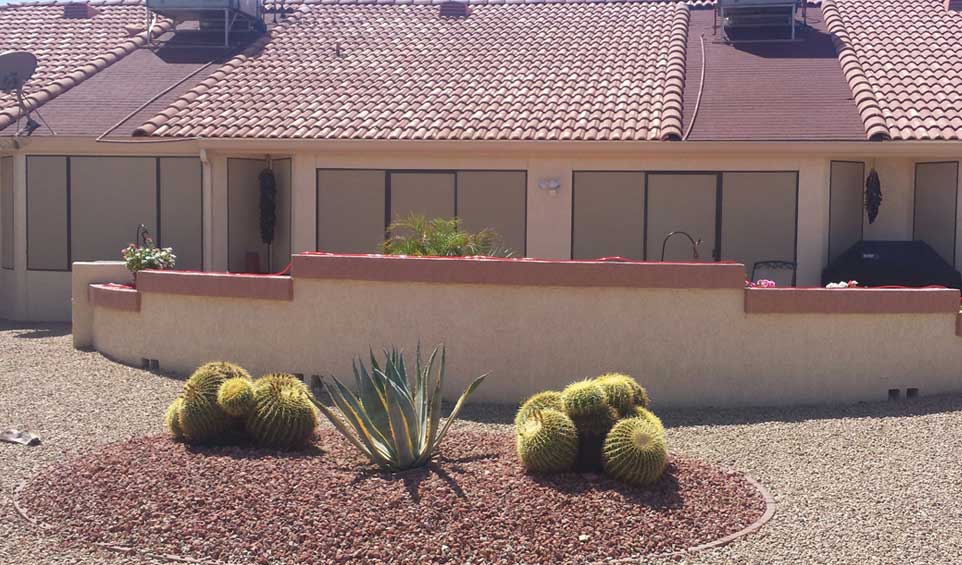- Making the Most of Your Patio with Stylish and Functional Shade Solutions - February 16, 2025
- How Shade Screens Can Help Reduce Cooling Costs with SRP Rebates - February 5, 2025
- The Health Benefits of Using Sunshades - January 26, 2025
Living in a desert environment poses unique challenges when it comes to maintaining a comfortable indoor temperature. The extreme temperature variations between scorching days and chilly nights demand thoughtful strategies to ensure a pleasant living space. In this article, we will explore effective ways to keep your desert home cool during the day and warm at night, combining practical solutions with sustainable practices for optimal comfort.
Daytime Cooling Strategies
Proper Insulation:
Adequate insulation is a cornerstone of temperature regulation in any home, especially in a desert environment. Good insulation helps keep the scorching heat outside during the day. Invest in quality insulation for your walls, roof, and windows to create a barrier against the intense sunlight.
Energy-Efficient Windows:
Opt for windows with low-emissivity (Low-E) coatings that reflect heat and UV rays, preventing them from penetrating your home. Double-pane or triple-pane windows also provide better insulation, reducing the transfer of outdoor temperatures inside.
Reflective Roofing:
Choose roofing materials with reflective surfaces, such as white or light-colored tiles. Reflective roofs can significantly reduce heat absorption, keeping your home cooler during the day. This simple adjustment can have a substantial impact on your overall energy consumption.
Strategic Landscaping:
Planting trees strategically around your home provides natural shade, reducing the direct impact of the sun. Deciduous trees, which shed their leaves in the winter, can allow sunlight to reach your home during the cooler months while providing shade in the summer.
Utilize Window Coverings:
Install shades, blinds, or curtains that are designed to block out sunlight during the hottest parts of the day. Consider reflective or blackout curtains to minimize heat transfer through windows. Closing them during peak daylight hours can significantly decrease indoor temperatures.
Nighttime Warming Strategies
Thermal Mass:
Leverage the principle of thermal mass by incorporating materials that absorb and store heat during the day and release it at night. Stone or adobe floors, for instance, can capture warmth during daylight hours and radiate it back into your home when temperatures drop.
Insulating Window Coverings:
While maintaining your daytime window coverings for insulation, consider adding thick curtains or drapes to trap heat inside during colder nights. This extra layer provides an additional barrier against nighttime chill.
Strategic Ventilation:
Open windows strategically to allow cool desert air to circulate during the evening. Create cross-ventilation by opening windows on opposite sides of the house to encourage the flow of fresh, cool air. This helps regulate indoor temperatures and promotes a more comfortable sleeping environment.
Utilize Energy-Efficient Heaters:
For those rare chilly desert nights, invest in energy-efficient heaters. Electric or gas-powered heaters can quickly warm up specific areas without consuming excessive energy. Ensure that your heating system is well-maintained and in good working order.
Smart Thermostat Usage:
Consider installing a smart thermostat that can be programmed to adjust temperatures based on your daily routine. Program it to lower temperatures during the night and raise them in the morning, creating an energy-efficient schedule that aligns with your lifestyle.
Conclusion
Maintaining a comfortable living environment in a desert home requires a holistic approach that addresses both daytime heat and nighttime cold. By combining proper insulation, energy-efficient windows, reflective roofing, strategic landscaping, and thoughtful window coverings, you can create a cool haven during scorching days. Similarly, employing thermal mass, insulating window coverings, strategic ventilation, energy-efficient heaters, and smart thermostat usage ensures warmth and coziness on chilly desert nights.
Implementing these strategies not only enhances your comfort but also contributes to energy efficiency and sustainability. As the world embraces eco-friendly practices, incorporating these tips into your desert home can help create a more harmonious and energy-conscious living space.

